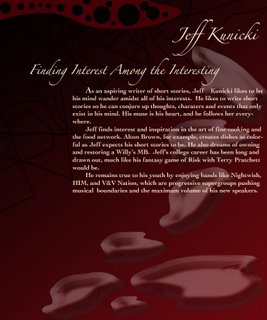1. The book talks of grouping certain things together because they "want" to be together. This is based on how things fall under categories. When someone is searching for a particular subject, they must follow different categories in which that subject pertains to. When designing, we must make sure our information is put into the right categories for our audience.
2. The ideas of giving a site personality were interesting, in their ability to create emotion in the audience; such as "get excited about football". However, I feel it is more pertaining to advertisements or product pages, not personal web sites.
3. Describing yourself is truly important. Telling the audience why you are unique is very crucial to the audience.
4. I really like sample combinations. I think this is part of my style or feel when designing in fact. I like to take parts of logos or images I've used and use them in other places and combined with other things I have created.
5.Mock up your navigations. Try different things before going with one too fast. You may find some things work better or happen to be better recevied by your audience.

